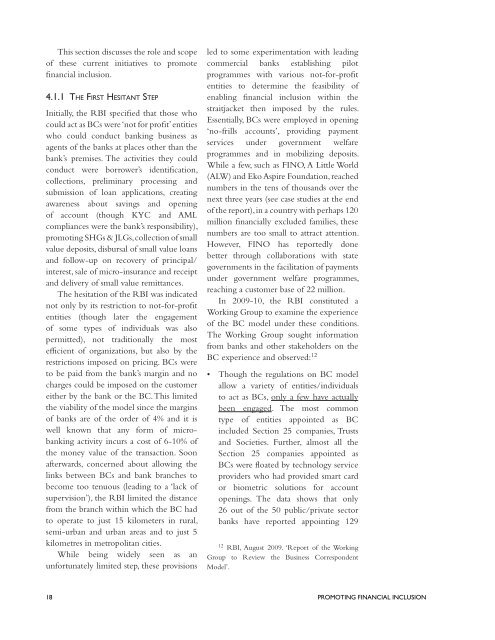Promoting Financial Inclusion - United Nations Development ...
Promoting Financial Inclusion - United Nations Development ...
Promoting Financial Inclusion - United Nations Development ...
You also want an ePaper? Increase the reach of your titles
YUMPU automatically turns print PDFs into web optimized ePapers that Google loves.
This section discusses the role and scope<br />
of these current initiatives to promote<br />
financial inclusion.<br />
4.1.1 THE FIRST HESITANT STEP<br />
Initially, the RBI specified that those who<br />
could act as BCs were ‘not for profit’ entities<br />
who could conduct banking business as<br />
agents of the banks at places other than the<br />
bank’s premises. The activities they could<br />
conduct were borrower’s identification,<br />
collections, preliminary processing and<br />
submission of loan applications, creating<br />
awareness about savings and opening<br />
of account (though KYC and AML<br />
compliances were the bank’s responsibility),<br />
promoting SHGs & JLGs, collection of small<br />
value deposits, disbursal of small value loans<br />
and follow-up on recovery of principal/<br />
interest, sale of micro-insurance and receipt<br />
and delivery of small value remittances.<br />
The hesitation of the RBI was indicated<br />
not only by its restriction to not-for-profit<br />
entities (though later the engagement<br />
of some types of individuals was also<br />
permitted), not traditionally the most<br />
efficient of organizations, but also by the<br />
restrictions imposed on pricing. BCs were<br />
to be paid from the bank’s margin and no<br />
charges could be imposed on the customer<br />
either by the bank or the BC. This limited<br />
the viability of the model since the margins<br />
of banks are of the order of 4% and it is<br />
well known that any form of microbanking<br />
activity incurs a cost of 6-10% of<br />
the money value of the transaction. Soon<br />
afterwards, concerned about allowing the<br />
links between BCs and bank branches to<br />
become too tenuous (leading to a ‘lack of<br />
supervision’), the RBI limited the distance<br />
from the branch within which the BC had<br />
to operate to just 15 kilometers in rural,<br />
semi-urban and urban areas and to just 5<br />
kilometres in metropolitan cities.<br />
While being widely seen as an<br />
unfortunately limited step, these provisions<br />
led to some experimentation with leading<br />
commercial banks establishing pilot<br />
programmes with various not-for-profit<br />
entities to determine the feasibility of<br />
enabling financial inclusion within the<br />
straitjacket then imposed by the rules.<br />
Essentially, BCs were employed in opening<br />
‘no-frills accounts’, providing payment<br />
services under government welfare<br />
programmes and in mobilizing deposits.<br />
While a few, such as FINO, A Little World<br />
(ALW) and Eko Aspire Foundation, reached<br />
numbers in the tens of thousands over the<br />
next three years (see case studies at the end<br />
of the report), in a country with perhaps 120<br />
million financially excluded families, these<br />
numbers are too small to attract attention.<br />
However, FINO has reportedly done<br />
better through collaborations with state<br />
governments in the facilitation of payments<br />
under government welfare programmes,<br />
reaching a customer base of 22 million.<br />
In 2009-10, the RBI constituted a<br />
Working Group to examine the experience<br />
of the BC model under these conditions.<br />
The Working Group sought information<br />
from banks and other stakeholders on the<br />
BC experience and observed: 12<br />
• Though the regulations on BC model<br />
allow a variety of entities/individuals<br />
to act as BCs, only a few have actually<br />
been engaged. The most common<br />
type of entities appointed as BC<br />
included Section 25 companies, Trusts<br />
and Societies. Further, almost all the<br />
Section 25 companies appointed as<br />
BCs were floated by technology service<br />
providers who had provided smart card<br />
or biometric solutions for account<br />
openings. The data shows that only<br />
26 out of the 50 public/private sector<br />
banks have reported appointing 129<br />
12<br />
RBI, August 2009. ‘Report of the Working<br />
Group to Review the Business Correspondent<br />
Model’.<br />
18 PROMOTING FINANCIAL INCLUSION

















